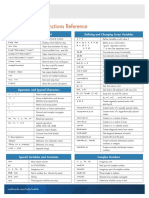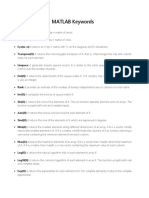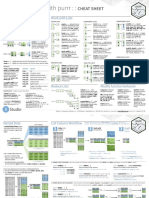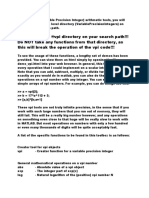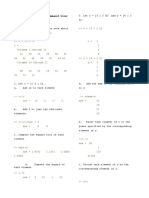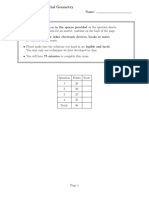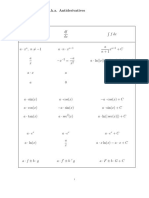How it works?
1. Enter text and formulas into the "Code" box on the left.
2. Press F5 or click to calculate. The results will appear in the "Output" box on the right as a
professionally formatted Html report.
3. Click to print or to copy the output.
You can also export it to Html , PDF or MS Word document.
The language
The Calcpad language includes the following elements (click an item to insert):
• Real numbers: digits 0 - 9 and decimal point ".";
• Complex numbers: re ± imi (e.g. 3 - 2i);
• Real vectors: [v1; v2; v3; ...; vn];
• Real matrices: [M11; M12; ... ; M1n | M21; M22; ... ; M2n ... | Mm1; Mm2; ... ; Mmn];
• Variables:
- Latin letters: a - z, A - Z;
- Greek letters: α - ω, Α - Ω;
- digits: 0 – 9;
- comma: “ , “;
- prime symbols: ′ , ″ , ‴ , ⁗ ;
- superscripts: ⁰ , ¹ , ² , ³ , ⁴ , ⁵ , ⁶ , ⁷ , ⁸ , ⁹ , ⁿ , ⁺ , ⁻ ;
- special symbols: ‾ , ø , Ø , ° , ∡ ;
- “ _ “ for subscript;
A variable name must start with a letter. Names are case sensitive.
• Constants:
π, e, φ, γ, g, G, M E , M S , c, h, μ 0 , ε 0 , k e , e , m e , m p , m n , N A , σ, k B , R, F, γ c , γ s , γ a , γ g , γ w
• Operators:
“!” – factorial;
“^” – exponent;
“/” – division;
“÷” – force division bar;
“\” – division;
“⦼” – modulo (reminder);
“*” – multiplication;
“-“ – minus;
“+” – plus;
“≡” – equal to;
“≠” – not equal to;
“<” – less than;
“>” – greater than;
“≤” – less or equal;
� “≥” – greater or equal;
“∧” – logical “AND”;
“∨” – logical “OR”;
“⊕” – logical “XOR”;
“=” – assignment;
• Custom functions type f (x; y; z; ...);
• Built-in functions:
◦ Trigonometric:
sin(x) - sine;
cos (x) - cosine;
tan (x) - tangent;
csc (x) - cosecant;
sec (x) - secant;
cot (x) - cotangent;
◦ Hyperbolic:
sinh (x) - hyperbolic sine;
cosh (x) - hyperbolic cosine;
tanh (x) - hyperbolic tangent;
csch (x) - hyperbolic cosecant;
sech (x) - hyperbolic secant;
coth (x) - hyperbolic cotangent;
◦ Inverse trigonometric:
asin(x) - inverse sine;
acos (x) - inverse cosine;
atan (x) - inverse tangent;
atan2 (x; y) - the angle whose tangent is the quotient of y and x;
acsc (x) - inverse cosecant;
asec (x) - inverse secant;
acot (x) - inverse cotangent;
◦ Inverse hyperbolic:
asinh (x) - inverse hyperbolic sine;
acosh (x) - inverse hyperbolic cosine;
atanh (x) - inverse hyperbolic tangent;
acsch (x) - inverse hyperbolic cosecant;
asech (x) - inverse hyperbolic secant;
acoth (x) - inverse hyperbolic cotangent;
�◦ Logarithmic, exponential and roots:
log (x) - decimal logarithm;
ln (x) - natural logarithm;
log_2(x) - binary logarithm;
exp(x) - exponential function;
sqr (x) or sqrt (x) - square root;
cbrt (x) - cubic root;
root (x; n) - n-th root;
◦ Rounding:
round (x) - round to the nearest integer;
floor (x) - round to the smaller integer (towards -∞);
ceiling (x) - round to the greater integer (towards +∞);
trunc (x) - round to the smaller integer (towards zero);
◦ Integer:
mod (x; y) - the reminder of an integer division;
gcd (x; y; z...) - the greatest common divisor of several integers;
lcm (x; y; z...) - the least common multiple of several integers;
◦ Complex:
abs (x) - absolute value/magnitude;
re (x) - the real part of a complex number;
im (x) - the imaginary part of a complex number;
phase (x) - the phase of a complex number;
◦ Aggregate and interpolation:
min (x; y; z...) - minimum of multiple values;
max (x; y; z...) - maximum of multiple values;
sum (x; y; z...) - sum of multiple values = x + y + z...;
sumsq (x; y; z...) - sum of squares = x² + y² + z²...;
srss (x; y; z...) - square root of sum of squares = sqrt (x² + y² + z²...);
average (x; y; z...) - average of multiple values = (x + y + z...)/n;
product (x; y; z...) - product of multiple values = x·y·z...;
mean (x; y; z...) - geometric mean = n-th root (x·y·z...);
take(n; a; b; c...) - returns the n-th element from the list;
line(x; a; b; c...) - linear interpolation;
spline (x; a; b; c...) - Hermite spline interpolation;
◦ Conditional and logical:
if (cond; value-if-true; value-if-false) - conditional evaluation;
� switch (cond1; value1; cond2; value2; …; default) - selective evaluation;
not (x) - logical "NOT";
and (x; y; z...) - logical "AND";
or (x; y; z...) - logical "OR";
xor (x; y; z...) - logical "XOR";
◦ Other:
sign (x) - sign of a number;
random (x) - random number between 0 and x;
◦ Vector:
vector (n) - creates an empty vector with length n;
fill (v⃗ ; x) - fills the vector v⃗ with value x;
range (x1; xn; s) - creates a vector with values spanning from x1 to xn with step s;
join (a⃗ ; b⃗ ; c…) - creates a vector by joining the arguments in the list - vectors and scalars;
slice (v⃗ ; i1; i2) - returns the part of the vector v⃗ bounded by indexes i1 and i2 inclusive;
resize (v⃗ ; n) - sets a new length n of the vector v⃗ ;
len ( v⃗ ) - returns the length of the vector v⃗ ;
size (v⃗ ) - the actual size of the vector v⃗ - the index of the last non-zero element;
first ( v⃗ ; n) - the first n elements of the vector v⃗ ;
last (v⃗ ; n) - the last n elements of the vector v⃗ ;
extract (v⃗ ; i⃗ ) - extracts those elements from v⃗ which indexes are contained in i⃗ ;
norm_1 (v⃗ ) - L1 (Manhattan) norm of the vector v⃗ ;
norm (v⃗ ) or
norm_2 (v⃗ ) or
norm_e (v⃗ ) - L2 (Euclidean) norm of the vector v⃗ ;
norm_p (v⃗ ; p) - Lp norm of the vector v⃗ ;
norm_i (v⃗ ) - L∞ (infinity) norm of the vector v⃗ ;
unit (v⃗ ) - normalized form of the vector v⃗ (with L2 norm = 1);
dot (a⃗ ; b⃗ ) - scalar product of two vectors a⃗ and b⃗ ;
cross (a⃗ ; b⃗ ) - cross product of two vectors a⃗ and b⃗ (with length 2 or 3);
sort (v⃗ ) - sorts the vector v⃗ in ascending order;
rsort (v⃗ ) - sorts the vector v⃗ in descending order;
order (v⃗ ) - the indexes of v⃗ , in ascending order by the elements of v⃗ ;
revorder (v⃗ ) - the indexes of v⃗ , in descending order by the elements of v⃗ ;
reverse (v⃗ ) - vector containing the elements of v⃗ in reverse order;
� count (v⃗ ; x; i) - the number of elements of v⃗ equal to x with index ≥ i;
search (v⃗ ; x; i) - the index of the first element in v⃗ with index ≥ i that is equal to x;
find (v⃗ ; x; i) or
find_eq (v⃗ ; x; i) - the indexes of all elements in v⃗ , after the i-th, that are = x;
find_ne (v⃗ ; x; i) - the indexes of all elements in v⃗ , after the i-th , that are ≠ x;
find_lt (v⃗ ; x; i) - the indexes of all elements in v⃗ , after the i-th, that are < x;
find_le (v⃗ ; x; i) - the indexes of all elements in v⃗ , after the i-th, that are ≤ x;
find_gt (v⃗ ; x; i) - the indexes of all elements in v⃗ , after the i-th, that are > x;
find_ge (v⃗ ; x; i) - the indexes of all elements in v⃗ , after the i-th, that are ≥ x;
lookup (a⃗ ; b⃗ ; x) or
lookup_eq (a⃗ ; b⃗ ; x) - all elements of a⃗ for which the corresponding elements of b⃗ are = x;
lookup_ne (a⃗ ; b⃗ ; x) - all elements of a⃗ for which the corresponding elements of b⃗ are ≠ x;
lookup_lt (a⃗ ; b⃗ ; x) - all elements of a⃗ for which the corresponding elements of b⃗ are < x;
lookup_le (a⃗ ; b⃗ ; x) - all elements of a⃗ for which the corresponding elements of b⃗ are ≤ x;
lookup_gt (a⃗ ; b⃗ ; x) - all elements of a⃗ for which the corresponding elements of b⃗ are > x;
lookup_ge (a⃗ ; b⃗ ; x) - all elements of a⃗ for which the corresponding elements of b⃗ are ≥ x;
min (v⃗ ) - the minimal element of the vector v⃗ ;
max (v⃗ ) - the maximal element of the vector v⃗ ;
sum (v⃗ ) - sum of all elements of the vector v⃗ ;
sumsq (v⃗ ) - sum of squares of all elements of the vector v⃗ ;
srss (v⃗ ) - square root of sum of squares of all elements of the vector v⃗ ;
average (v⃗ ) - average of all elements of the vector v⃗ ;
product (v⃗ ) - product of all elements of the vector v⃗ ;
mean (v⃗ ) - geometric mean of all elements of the vector v⃗ ;
take (x; v⃗ ) - return the x-th element of the vector v⃗ ;
line (x; v⃗ ) - linear interpolation of the elements of the vector v⃗ by the value of x;
spline (x; v⃗ ) - Hermite spline interpolation;
o Matrix:
matrix (m; n) - creates an empty matrix with dimensions m⨯n;
identity (n) - creates an identity matrix with dimensions n⨯n;
diagonal (n; d) - creates a diagonal matrix with dimensions n⨯n and fills the diagonal
with value d;
column (m; c) - creates a column matrix with dimensions m⨯1, filled with value c;
�utriang (n) - creates an upper triangular matrix with dimensions n⨯n;
ltriang (n) - creates a lower triangular matrix with dimensions n⨯n;
symmetric (n) - creates a symmetric matrix with dimensions n⨯n;
vec2diag (⃗v) - creates a diagonal matrix from the elements of vector ⃗v;
vec2col (⃗v) - creates a column matrix from the elements of vector ⃗v;
join_cols (⃗c1; ⃗c2; ⃗c3...) - creates a matrix by joining column vectors;
join_rows (⃗r1; ⃗r2; ⃗r3...) - creates a matrix by joining row vectors;
augment (A; B; C...) - creates a matrix by appending matrices A; B; C side by side;
stack (A; B; C...) - creates a matrix by stacking matrices A; B; C one below the other;
resize (M; m; n) - sets new dimensions m and n for matrix M;
fill (M; x) - fills the matrix M with value x;
fill_row (M; x; i) - fills the i-th row of matrix M with value x;
fill_col (M; x; j) - fills the j-th column of matrix M with value x;
copy (A; B; i; j) - copies all elements from A to B, starting from indexes i and j of B;
add (A; B; i; j) - adds all elements from A to those of B, starting from indexes i and j of B;
n_rows (M) - number of rows in matrix M;
n_cols (M) - number of columns in matrix M;
rowsize (M; i) - the actual size of row i of matrix M, filled with non-zero elements;
row (M; i) - extracts the i-th row of matrix M as a vector;
col (M; j) - extracts the j-th column of matrix M as a vector;
submatrix (M; i1; i2; j1; j2) - extracts a submatrix of M, bounded between rows i1 and i2
and columns j1 and j2, incl.;
extract_rows (M; i⃗ ) - extracts the rows from matrix M whose indexes are contained
in vector i⃗ ;
extract_cols (M; j⃗ ) - extracts the columns from matrix M whose indexes are contained
in vector j⃗ ;
hprod (A; B) - Hadamard product of matrices A and B;
fprod (A; B) - Frobenius product of matrices A and B;
kprod (A; B) - Kronecker product of matrices A and B;
mnorm (M) or
mnorm_e (M) - Euclidean norm of matrix M;
mnorm_1(M) - L1 norm of matrix M;
mnorm_2 (M) - L2 norm of matrix M;
mnorm_i (M) - L∞ norm of matrix M;
cond (M) or
�cond_e(M) - condition number of M based on the Euclidean norm of the matrix;
cond_1 (M) - condition number of M based on the L1 norm;
cond_2 (M) - condition number of M based on the L2 norm;
cond_i (M) - condition number of M based on the L∞ norm;
det (M) - determinant of matrix M;
rank (M) - rank of matrix M;
trace (M) - trace of matrix M;
transp (M) - transpose of matrix M;
adj (M) - adjugate of matrix M;
cofactor (M) - cofactor matrix of M;
eigenvals(M) - eigenvalues of matrix M;
eigenvecs (M) - eigenvectors of matrix M;
cholesky (M) - Cholesky decomposition of a symmetric, positive-definite matrix M;
lu (M) - LU decomposition of matrix M;
qr (M) - QR decomposition of matrix M;
svd (M) - singular value decomposition of M;
inverse (M) - inverse of matrix M;
lsolve (A; b) - solves the system of linear equations Ax = b using LDLT decomposition for
symmetric matrices, and LU for non-symmetric;
clsolve (A; b) - solves the linear matrix equation Ax = b with a symmetric,
positive-definite matrix A using Cholesky decomposition;
sort_cols (M; i) - sorts the columns of M based on the values in row i
in ascending order;
rsort_cols (M; i) - sorts the columns of M based on the values in row i
in descending order;
sort_rows (M; j) - sorts the rows of M based on the values in column j
in ascending order;
rsort_rows (M; j) - sorts the rows of M based on the values in column j
in descending order;
order_cols (M; i) - the indexes of the columns of M in ascending order by
the values in row i;
revorder_cols (M; i) - the indexes of the columns of M in descending order by
the values in row i;
order_rows (M; j) - the indexes of the rows of M in ascending order by
the values in column j;
revorder_rows (M; j) - the indexes of the rows of M in descending order by
� the values in column j;
mcount (M; x) - number of occurrences of value x in matrix M;
msearch (M; x; i; j) - vector with the two indexes of the first occurrence of x in the
matrix M, starting from indexes i and j;
mfind (M; x) - the indexes of all elements in matrix M equal to x;
mfind_eq (M; x) - the indexes of all elements in matrix M equal to x;
mfind_ne (M; x) - the indexes of all elements in matrix M not equal to x;
mfind_lt(M; x) - the indexes of all elements in matrix M less than x;
mfind_le(M; x) - the indexes of all elements in matrix M less than or equal to x;
mfind_gt (M; x) - the indexes of all elements in matrix M greater than x;
mfind_ge (M; x) - the indexes of all elements in matrix M greater than or equal to x;
hlookup (M; x; i1; i2) - the values from row i2 of M, for which the elements from
row i11 are equal to x;
hlookup_eq (M; x; i1; i2) - the values from row i2 of M, for which the elements from
row i1 are equal to x;
hlookup_ne (M; x; i1; i2) - the values from row i2 of M, for which the elements from
row i1 are not equal to x;
hlookup_lt (M; x; i1; i2) - the values from row i22 of M, for which the elements from
row i11 are less than x;
hlookup_le (M; x; i1; i2) - the values from row i2 of M, for which the elements from
row i1 are less than or equal to x;
hlookup_gt (M; x; i1; i2) - the values from row i2 of M, for which the elements from
row i1 are greater than x;
hlookup_ge (M; x; i1; i2) - the values from row i2 of M, for which the elements from
row i1 are greater than or equal to x;
vlookup (M; x; j1; j2) - the values from column j2 of M, for which the elements from
column j1 are equal to x;
vlookup_eq (M; x; j1; j2) - the values from column j2 of M, for which the elements from
column j1 are equal to x;
vlookup_ne (M; x; j1; j2) - the values from column j2 of M, for which the elements from
column j1 are not equal to x;
vlookup_lt (M; x; j1; j2) - the values from column j2 of M, for which the elements from
column j1 are less than x;
vlookup_le (M; x; j11; j2) - the values from column j2 of M, for which the elements from
column j1 are less than or equal to x;
vlookup_gt (M; x; j1; j2) - the values from column j2 of M, for which the elements from
� column j1 are greater than x;
vlookup_ge (M; x; j1; j2) - the values from column j2 of M, for which the elements from
column j1 are greater than or equal to x;
min (M) - minimal element of matrix M;
max (M) - maximal element of matrix M;
sum (M) - sum of the elements of matrix M;
sumsq (M) - sum of the squares of the elements of matrix M;
srss (M) - square root of the sum of squares;
average (M) - arithmetic mean of the elements of matrix M;
product (M) - product of the elements of matrix M;
mean (M) - geometric mean of the elements of matrix M;
take (x; y; M) - returns the element of matrix M at indexes x and y;
line (x; y; M) - double linear interpolation from the elements of matrix M based on
the values of x and y;
spline (x; y; M) - double Hermite spline interpolation from the elements of matrix M
based on the values of x and y.
• Comments: "Title" or 'text' in double or single quotes, respectively.
HTML, CSS, JS and SVG are allowed.
• Graphing and plotting:
$Plot { f (x) @ x = a : b } - simple plot;
$Plot { x (t) | y (t) @ t = a : b } - parametric;
$Plot { f 1 (x) & f 2 (x) & ... @ x = a : b } - multiple;
$Plot { x 1 (t) | y 1 (t) & x2 (t) | y 2 (t) & ... @ x = a : b } - multiple parametric;
$Map { f (x; y ) @ x = a : b & y = c : d } - 2D color map of a 3D surface;
PlotHeight - height of plot area in pixels;
PlotWidth - width of plot area in pixels;
PlotStep - grid size for map plotting.
• Iterative and numerical methods:
$Root { f (x) = const @ x = a : b } - root finding for f (x) = const;
$Root { f (x) @ x = a : b } - root finding for f (x) = 0;
$Find { f (x) @ x = a : b } - similar to above, but x is not required to be a precise solution;
$Sup { f (x) @ x = a : b } - local maximum of a function;
$Inf { f (x) @ x = a : b } - local minimum of a function;
$Area { f (x) @ x = a : b } - adaptive Gauss-Lobatto numerical integration;
$Integral { f (x) @ x = a : b } - Tanh-Sinh numerical integration;
$Slope { f (x) @ x = a } - numerical differentiation;
$Sum { f (x) @ k = a : b } - iterative sum;
� $Product { f (k) @ k = a : b } - iterative product;
$Repeat { f (k) @ k = a : b } - general inline iterative procedure;
Precision - relative precision for numerical methods [10 -2; 10 -16] (default is 10 -12)
• Program flow control:
Simple:
#if condition
your code goes here
#end if
Alternative:
#if condition
your code goes here
#else
some other code
#end if
Complete:
#if condition1
your code goes here
#else if condition2
your code goes here
#else
some other code
#end if
You can add or omit as many "#else ifs" as needed. Only one "#else" is allowed.
You can omit this too.
• Iteration blocks:
Simple:
#repeat number of repetitions
your code goes here
#loop
With conditional break/continue:
#repeat number of repetitions
your code goes here
#if condition
#break or #continue
#end if
some more code
#loop
• Modules and macros/string variables:
Modules:
#include filename - include external file (module);
#local - start local section (not to be included);
� #global - start global section (to be included);
Inline string variable:
#def variable_name$ = content
Multiline string variable:
#def variable_name$
content line 1
content line 2
...
#end def
Inline macro:
#def macro_name$(param1$; param2$; ...) = content
Multiline macro:
#def macro_name$(param1$; param2$; ...)
content line 1
content line 2
...
#end def
• Output control:
#hide - hide the report contents;
#show - always show the contents (default);
#pre - show the next contents only before calculations;
#post - show the next contents only after calculations;
#val - show only the result, without the equation;
#equ - show complete equations and results (default);
#noc - show only equations without results (no calculations);
#nosub - do not substitute variables (no substitution);
#novar - show equations only with substituted values (no variables);
#varsub - show equations with variables and substituted values (default);
#round n - rounds the output to n digits after the decimal point.
• Breakpoints for step-by-step execution:
#pause - calculates down to the current line and waits for the user to resume manually;
#input - renders an input form to the current line and waits for user input.
Each of the above commands is effective after the current line until the end of the report or
another command that overwrites it.
• Units for trigonometric functions: #deg - degrees, #rad - radians, #gra - gradians;
• Separator for target units: |;
• Return angles with units: ReturnAngleUnits = 1;
• Dimensionless: %, ‰;
• Angle: °, ′, ″, deg, rad, grad, rev;
• Metric units (SI and compatible):
Mass: g, hg, kg, t, kt, Mt, Gt, dg, cg, mg, μg, Da (or u);
� Length: m, km, dm, cm, mm, μm, nm, pm, AU, ly;
Time: s, ms, μs, ns, ps, min, h, d, w, y;
Frequency: Hz, kHz, MHz, GHz, THz, mHz, μHz, nHz, pHz, rpm;
Speed: kmh;
Electric current: A, kA, MA, GA, TA, mA, μA, nA, pA;
Temperature: °C, Δ°C, K;
Amount of substance: mol;
Luminous intensity: cd;
Area: a, daa, ha;
Volume: L, daL, hL, dL, cL, mL, μL, nL, pL;
Force: N, daN, hN, kN, MN, GN, TN, gf, kgf, tf, dyn;
Moment: Nm, kNm;
Pressure: Pa, daPa, hPa, kPa, MPa, GPa, TPa, dPa, cPa, mPa, μPa, nPa, pPa,
bar, mbar, μbar, atm, at, Torr, mmHg;
Viscosity: P, cP, St, cSt;
Energy work: J, kJ, MJ, GJ, TJ, mJ, μJ, nJ, pJ,
Wh, kWh, MWh, GWh, TWh, mWh, μWh, nWh, pWh,
eV, keV, MeV, GeV, TeV, PeV, EeV, cal, kcal, erg;
Power: W, kW, MW, GW, TW, mW, μW, nW, pW, hpM, ks,
VA, kVA, MVA, GVA, TVA, mVA, μVA, nVA, pVA,
VAR, kVAR, MVAR, GVAR, TVAR, mVAR, μVAR, nVAR, pVAR;
Electric charge: C, kC, MC, GC, TC, mC, μC, nC, pC, Ah, mAh;
Potential: V, kV, MV, GV, TV, mV, μV, nV, pV;
Capacitance: F, kF, MF, GF, TF, mF, μF, nF, pF;
Resistance: Ω, kΩ, MΩ, GΩ, TΩ, mΩ, μΩ, nΩ, pΩ;
Conductance: S, kS, MS, GS, TS, mS, μS, nS, pS, ℧, k℧, M℧, G℧, T℧, m℧, μ℧, n℧, p℧;
Magnetic flux: Wb , kWb, MWb, GWb, TWb, mWb, μWb, nWb, pWb;
Magnetic flux density: T, kT, MT, GT, TT, mT, μT, nT, pT;
Inductance: H, kH, MH, GH, TH, mH, μH, nH, pH;
Luminous flux: lm;
Illuminance: lx;
Radioactivity: Bq, kBq, MBq, GBq, TBq, mBq, μBq, nBq, pBq, Ci, Rd;
Absorbed dose: Gy, kGy, MGy, GGy, TGy, mGy, μGy, nGy, pGy;
Equivalent dose: Sv, kSv, MSv, GSv, TSv, mSv, μSv, nSv, pSv;
Catalytic activity: kat;
• Non-metric units (Imperial/US):
Mass: gr, dr, oz, lb (or lbm, lb_m), kipm (or kip_m), st, qr,
cwt (or cwt_UK, cwt_US), ton (or ton_UK, ton_US), slug;
Length: th, in, ft, yd, ch, fur, mi, ftm (or ftm_UK, ftm_US),
cable (or cable_UK, cable_US), nmi, li, rod, pole, perch, lea;
� Speed: mph, knot;
Temperature: °F, Δ°F, °R;
Area: rood, ac;
Volume, fluid: fl_oz, gi, pt, qt, gal, bbl, or:
fl_oz_UK, gi_UK, pt_UK, qt_UK, gal_UK, bbl_UK,
fl_oz_US, gi_US, pt_US, qt_US, gal_US, bbl_US;
Volume, dry: (US) pt_dry, (US) qt_dry, (US) gal_dry, (US) bbl_dry,
pk (or pk_UK, pk_US), bu (or bu_UK, bu_US);
Force: ozf (or oz_f), lbf (or lb_f), kip (or kipf, kip_f), tonf (or ton_f), pdl;
Pressure: osi, osf psi, psf, ksi, ksf, tsi, tsf, inHg;
Energy/work: BTU, therm (or therm_UK, therm_US), quad;
Power: hp, hpE, hpS;
• Custom units - .Name = expression.
Names can include currency symbols: €, £, ₤, ¥, ¢, ₽, ₹, ₩, ₪.















